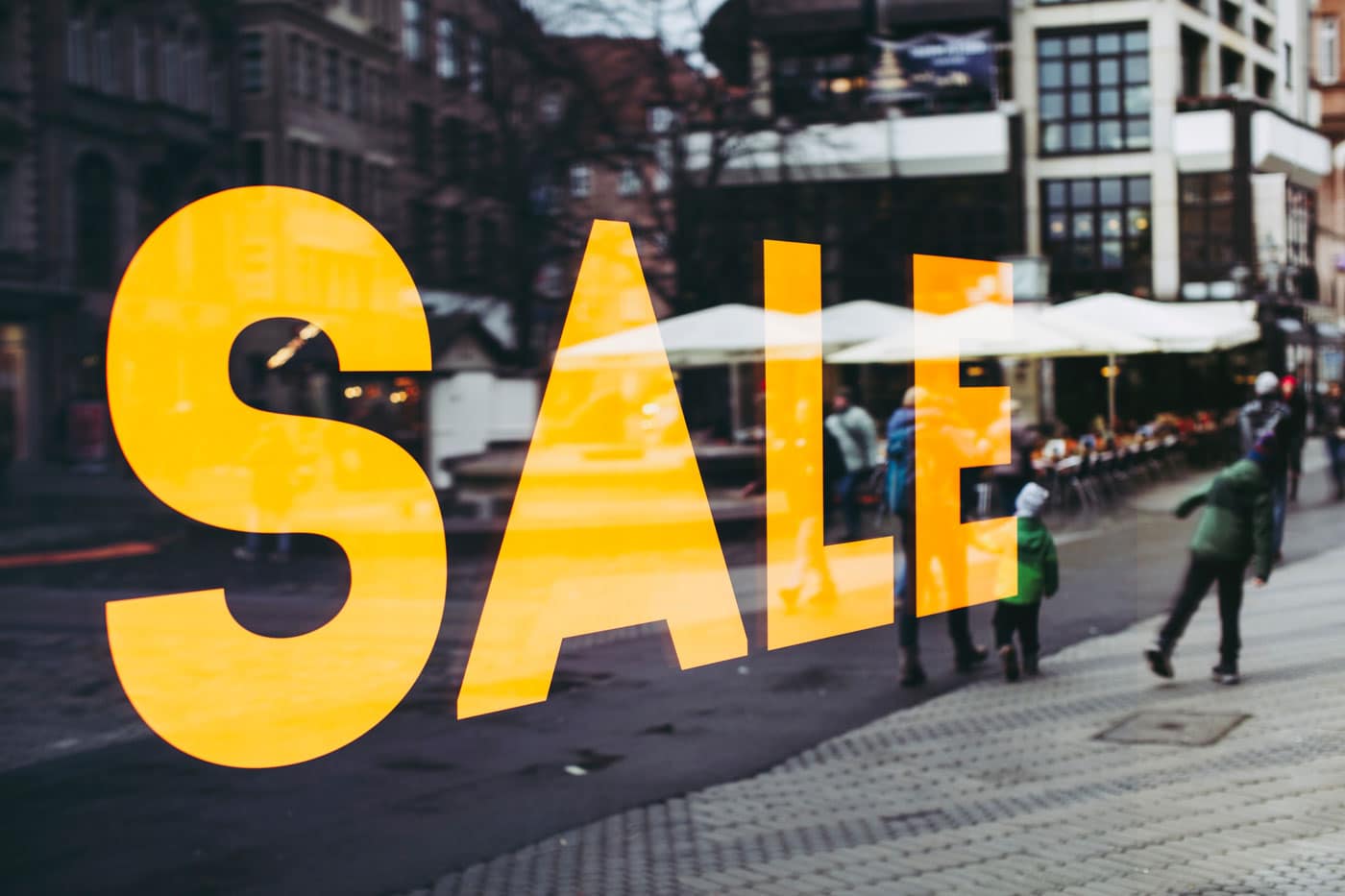We’ve all experienced the frustrations of choice paralysis – too many options for a particular product can lead to long pauses in grocery aisles and an unnecessary source of shopping spree stress.
As customers are flooded with more and more product choices in big-box grocery retail stores and online, their ability to distinguish which product is the best fit for them is becoming increasingly difficult.
The good news is, retailers and suppliers can help alleviate this feeling by listening to what customers are looking for and helping them identify which products are right for them. The simplest way to accomplish this is through clear and effective POP signage and point of sale signage.
What is POP Signage?
POP signage refers to any sign installed directly at the “Point of Product” in a retail environment. POP signage often lives on a retail shelf directly below the product, but this term could also refer to any other signage within the same line of sight as the product itself.
29% of customers make decisions based on information communicated to them through in-store signage. POP signage gives brands and retailers the ability to tell a story, convey a selling point or differentiator, build brand awareness, or otherwise help a retail shopper learn about a specific brand or product.
Retailers often sell tens of thousands of products under one roof, so anytime a brand creates a touchpoint or connection that differentiates their products from everything else on the shelf, they have a better chance at standing out from the competition. POP signage is one way that suppliers, distributors, and retailers can do just that.
Six Real-World Examples of POP Signage
- Shelf Talkers
- Bib Tags
- Aisle Blades
- Shelf Flags
- Bottle Neckers
- Floor Vinyl
SHELF TALKERS
Shelf Talkers (also known as Shelf Shouters, 4ups, or 6ups) usually appear directly under the product on the shelf and to the right of the price tag. This type of POP signage helps differentiate specific products within the same 4’-6’ set.
Here’s how they work in the store. Let’s say a customer walks past the category they are looking for — barbecue sauces. They look at the shelf and see 32 different SKUs. How do they decide which option to choose? Shelf talkers help influence this shopper and communicate which items in that set are the most interesting.
Best For: Differentiating similar items within a product set.
BIB TAGS
Price tags and price signage are the most highly read types of signage in the store for obvious reasons. Bib tags live right on a product’s price tag, giving them the highest chances of being noticed and read. Calling out important information with a bib tag will give you the highest likelihood of communicating your message effectively.
But here’s the catch: your message needs to be short. Like, two words short. Think “Sale” or “Gluten-Free” or “New!”. Bib tags typically help brands communicate individual attributes that may be important to the shopper, not a more in-depth story about the item.
Best For: Communicating brief attributes about a specific product.
AISLE BLADES
Shelf blades hang perpendicular to the shelf and are relatively large (like an 8.5”x11” sheet of folded in half hot dog style). Blades are generally printed on a thicker substrate like Sintra, PVC, foam core, or corrugated cardboard so they can withstand being hit by shopping carts.
In short, shelf blade POP signage is designed to catch a shoppers’ eye before they even consider shopping within your product set.
Have you ever stood at the end of a grocery aisle and stared down it to try to decide if there’s anything you need in that aisle? That is the shopper that shelf blades are designed for. Use them to persuade shoppers to enter that aisle and head straight for your product.
Best For: Driving sales and awareness with customers who hadn’t planned to shop for your products.
SHELF FLAGS
Shelf flags are similar to blades in that they hang perpendicular to the shelf. However, they are generally smaller and can be used more frequently than blades. They’re especially effective if you have several similar items within the same product set.
Let’s say your brand makes packaged rice and grain mixes, all of which are organic, and you have 12 different SKUs merchandised in the same 4’ set. If you put a shelf flag on each SKU to call out that they’re organic, you can quickly make an impact with the repetition of messaging on that set.
Best For: Building brand awareness of specific product attributes through repetition.
BOTTLE NECKERS
Bottle Neckers are signs that hang around the neck of a bottle, which means they’re only applicable for specific product types. Unlike most other types of POP signage, neckers are placed directly on each item instead of being attached to the shelf itself. Since neckers are installed directly on the products themselves, you don’t need to worry about them being taken down or misused in a retail storefront.
Because this is demanding on labor, brands typically use this type of signage for things like coupons – if you’re going to take the time to hang a sign around every product, you want it to be a compelling offer that directly drives sales.
Best For: High-impact sales offers like coupons.
FLOOR VINYL
Thinking about going bigger than shelf shouters and bib tags? Floor vinyl can help you make a splash with disruptive messaging that will call a lot of attention to your brand. Floor vinyl is basically a large sticker applied to the floor in front of your product set. While a high-impact marketing tactic, floor vinyl can be challenging to get approved by the retailer and requires a higher-labor, higher-cost application than other types of POP signage.
If you do produce floor vinyl, consider incorporating an image of the product itself into the design – that will make it easy for a shopper to connect the dots between what is on the signage and what is on the shelf.
Best For: High-disruption messaging and influence.
How to Get the Best ROI on Your POP Signage
The last thing that you want is to print and ship high-quality POP signage for your brand, only to find it either hasn’t been installed in stores or has been installed but is quickly removed. This is a waste of money, time, and effort for the supplier, distributor, and retailer.
So, how can you avoid this situation and make sure your POP signage campaign goes off without a hitch?
UNDERSTAND EACH RETAILER'S RULES OF ENGAGEMENT
Each retailer has different guidelines for POP signage. Some may not allow it in their stores at all, while others have relatively relaxed regulations regarding supplier signage.
If a retailer won’t allow supplier signage, work with your purchasing contact to explore the possibility of using co-created signage to support your products. Your purchasing contact likely has a direct line to the retailer’s marketing team and can request supporting signage when they feel it is appropriate. Work with them to communicate key messaging points and timelines to the marketing team.
Retailers with fewer regulations are more likely to allow POP signage but less reliable when it comes to installation. You can ensure proper execution in these situations by sending your own reps or brokers into the retail locations to install signage themselves.
Looking to be more methodical with your focus? Focus on suburban or rural areas first that tend to have fewer stores clustered nearby. Consider how your full program works as a whole – if you are offering promotional discounts in suburban areas, what other marketing promotions are you coordinating in those same areas?
AGREE ON PLACEMENT AND FORMAT UPFRONT
Most retailers don’t like surprises! And POP signage that doesn’t align with their expectations may get rotated off the floor quickly.
Rather than flying blind, work with your purchasing contact to establish commitments for usage before shipping to stores. Talk through sizing, quantity, and the logistics of installation. Be communicative and collaborative from the very beginning to get the best result.
AVOID A ONE-SIZE-FITS-ALL APPROACH
Steer clear of the “this sign size doesn’t work for my store” conversation by developing options for sign size and quantity based on store size and available fixtures.
You’ll likely want to create several ‘tiers’ of signage to give yourself the best chance of having signage installed correctly across locations.
CHECK OUT YOUR POP SIGNAGE IN PERSON
If you can’t confirm that your POP signage campaign has been executed in full or correctly, you’ll have a difficult time measuring performance or identifies future marketing opportunities for the future. In-person confirmation will help you answer this question: Did the messaging not resonate with the customer, or did the customer never get a chance to see the messaging?
After your new POP signage launches, you’ll want to follow up with retailers in person to ensure it’s being used effectively. Depending on the number of retail partners you have, you may even be able to send in a team of ‘secret shoppers’ to assess how well retailers have implemented your signage.
Partnering with retailers to deliver effective POP signage can help you to drive sales at the point of product and build overall brand awareness and consideration for your brand. Messaging at the point of product is especially important when you are launching a new product into retail, and helps you to communicate the discounts that you’ve created in your promotional planning strategy.
Even if a shopper reads your sign and decides not to buy the item on this trip, you’ve still educated them about your products and are improving your chances that they’ll recall your product in the future and purchase it at a later date.
Consider what type of POP signage is right for your product, and right for your retail partners to determine the most effective strategy to pursue.




